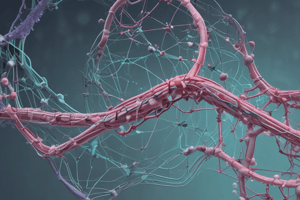Podcast
Questions and Answers
How does the binding of a hormone to its response element affect gene expression?
How does the binding of a hormone to its response element affect gene expression?
It alters the rate of expression of certain genes by increasing or decreasing the transcription of target genes.
What is the role of cAMP response element-binding (CREB) protein in cellular signaling?
What is the role of cAMP response element-binding (CREB) protein in cellular signaling?
CREB acts as a transcription factor that binds to specific response element sequences on DNA, initiating the transcription of target genes.
Explain how steroid hormones can modulate gene transcription.
Explain how steroid hormones can modulate gene transcription.
Steroid hormones bind to ligand-activated nuclear receptors, resulting in either activation or suppression of gene transcription.
Describe the mechanism by which insulin influences gene expression in diabetes treatment.
Describe the mechanism by which insulin influences gene expression in diabetes treatment.
How do calcineurin inhibitors contribute to immune response suppression?
How do calcineurin inhibitors contribute to immune response suppression?
What defines a hormone response element (HRE), and why is it significant?
What defines a hormone response element (HRE), and why is it significant?
What effects do second messengers have in cellular signaling pathways?
What effects do second messengers have in cellular signaling pathways?
Why is pharmacological modulation of gene transcription important in drug action?
Why is pharmacological modulation of gene transcription important in drug action?
Discuss the dual approach in pharmacological modulation of gene expression examples.
Discuss the dual approach in pharmacological modulation of gene expression examples.
What factors influence the half-life of proteins, and how do destabilizing N-terminal residues affect it?
What factors influence the half-life of proteins, and how do destabilizing N-terminal residues affect it?
Describe the role of poly-ubiquination in protein degradation and its association with disease.
Describe the role of poly-ubiquination in protein degradation and its association with disease.
What is the primary function of peroxisomes in cellular metabolism?
What is the primary function of peroxisomes in cellular metabolism?
How do inclusions differ from organelles in cellular functions?
How do inclusions differ from organelles in cellular functions?
What is glycogen, and where is it predominantly stored in the human body?
What is glycogen, and where is it predominantly stored in the human body?
What is the primary purpose of regulating gene expression?
What is the primary purpose of regulating gene expression?
Differentiate between constitutive and regulated gene expression.
Differentiate between constitutive and regulated gene expression.
What are inducible genes and how do they respond to molecular signals?
What are inducible genes and how do they respond to molecular signals?
Explain the role of chromatin in the regulation of gene expression.
Explain the role of chromatin in the regulation of gene expression.
How do histone modifications impact gene expression?
How do histone modifications impact gene expression?
What is the significance of the central dogma in understanding gene expression regulation?
What is the significance of the central dogma in understanding gene expression regulation?
Why are repressible genes important in cellular response to environmental changes?
Why are repressible genes important in cellular response to environmental changes?
How does autophagy support cellular metabolism during starvation?
How does autophagy support cellular metabolism during starvation?
What is the dual role of autophagy in cancer development?
What is the dual role of autophagy in cancer development?
In what kinds of diseases is autophagy implicated?
In what kinds of diseases is autophagy implicated?
How can intermittent fasting influence autophagy and weight loss?
How can intermittent fasting influence autophagy and weight loss?
What role do proteasomes play in protein degradation?
What role do proteasomes play in protein degradation?
Explain the process of ubiquitination in protein degradation.
Explain the process of ubiquitination in protein degradation.
What determines the rate of ubiquitination and degradation of a protein?
What determines the rate of ubiquitination and degradation of a protein?
What happens to ubiquitin molecules after a protein is degraded by proteasomes?
What happens to ubiquitin molecules after a protein is degraded by proteasomes?
Why is the regulation of cytosolic proteolysis significant for the cell?
Why is the regulation of cytosolic proteolysis significant for the cell?
How might pharmacological stimulation of autophagy affect obesity?
How might pharmacological stimulation of autophagy affect obesity?
What determines the half-life of different proteins?
What determines the half-life of different proteins?
Describe the role of lysosomal enzymes in protein degradation.
Describe the role of lysosomal enzymes in protein degradation.
How do protease inhibitors function in the treatment of viral infections?
How do protease inhibitors function in the treatment of viral infections?
What is the main function of autophagy in a cell?
What is the main function of autophagy in a cell?
Explain how substances reach lysosomes for degradation.
Explain how substances reach lysosomes for degradation.
What role do peroxisomes play in cellular adaptation to stress?
What role do peroxisomes play in cellular adaptation to stress?
Connect the structure of a proteasome to its function.
Connect the structure of a proteasome to its function.
What types of materials can lysosomes digest?
What types of materials can lysosomes digest?
Justify the importance of lysosomes in cellular health.
Justify the importance of lysosomes in cellular health.
What is the significance of the acidic pH within lysosomes?
What is the significance of the acidic pH within lysosomes?
Flashcards
Polymorphisms
Polymorphisms
Variations in DNA sequences among individuals. These variations can be used for screening people at risk for certain diseases.
Gene Expression Regulation
Gene Expression Regulation
The control of how much of a protein is made from a gene.
Constitutive Gene Expression
Constitutive Gene Expression
When a gene is always expressed, regardless of signals.
Housekeeping Genes
Housekeeping Genes
Signup and view all the flashcards
Regulated Gene Expression
Regulated Gene Expression
Signup and view all the flashcards
Inducible Genes
Inducible Genes
Signup and view all the flashcards
Repressible Genes
Repressible Genes
Signup and view all the flashcards
Chromatin Remodeling
Chromatin Remodeling
Signup and view all the flashcards
Euchromatin
Euchromatin
Signup and view all the flashcards
Heterochromatin
Heterochromatin
Signup and view all the flashcards
Histone Acetylation
Histone Acetylation
Signup and view all the flashcards
Autophagy on Starvation
Autophagy on Starvation
Signup and view all the flashcards
Autophagy and Cancer
Autophagy and Cancer
Signup and view all the flashcards
Autophagy and Diseases
Autophagy and Diseases
Signup and view all the flashcards
Proteasomes
Proteasomes
Signup and view all the flashcards
Proteolysis
Proteolysis
Signup and view all the flashcards
Ubiquitin Tagging
Ubiquitin Tagging
Signup and view all the flashcards
Proteasome Degradation Process
Proteasome Degradation Process
Signup and view all the flashcards
Receptor-Ligand Complex
Receptor-Ligand Complex
Signup and view all the flashcards
Response Element
Response Element
Signup and view all the flashcards
Hormone Response Element (HRE)
Hormone Response Element (HRE)
Signup and view all the flashcards
Gene Expression
Gene Expression
Signup and view all the flashcards
Cell Surface Receptors
Cell Surface Receptors
Signup and view all the flashcards
Second Messenger
Second Messenger
Signup and view all the flashcards
Kinase
Kinase
Signup and view all the flashcards
CREB Protein
CREB Protein
Signup and view all the flashcards
Pharmacological Modulation of Gene Transcription
Pharmacological Modulation of Gene Transcription
Signup and view all the flashcards
Nuclear Receptor Superfamily
Nuclear Receptor Superfamily
Signup and view all the flashcards
Glucocorticoids
Glucocorticoids
Signup and view all the flashcards
Diabetes Mellitus
Diabetes Mellitus
Signup and view all the flashcards
Calcineurin Inhibitors
Calcineurin Inhibitors
Signup and view all the flashcards
Protein Half-life
Protein Half-life
Signup and view all the flashcards
Lysosomal Enzymes
Lysosomal Enzymes
Signup and view all the flashcards
Proteases
Proteases
Signup and view all the flashcards
Autophagy
Autophagy
Signup and view all the flashcards
Lysosomes
Lysosomes
Signup and view all the flashcards
Acid Hydrolases
Acid Hydrolases
Signup and view all the flashcards
Phagosomes
Phagosomes
Signup and view all the flashcards
Pinocytotic Vesicles
Pinocytotic Vesicles
Signup and view all the flashcards
Autophagosomes
Autophagosomes
Signup and view all the flashcards
Autolysosome
Autolysosome
Signup and view all the flashcards
Phagolysosome
Phagolysosome
Signup and view all the flashcards
Proteasome
Proteasome
Signup and view all the flashcards
Peroxisomes
Peroxisomes
Signup and view all the flashcards
Cytoplasmic Inclusions
Cytoplasmic Inclusions
Signup and view all the flashcards
Protein Half-life
Protein Half-life
Signup and view all the flashcards
Crystallins
Crystallins
Signup and view all the flashcards
Hemoglobin
Hemoglobin
Signup and view all the flashcards
N-end rule
N-end rule
Signup and view all the flashcards
PEST sequences
PEST sequences
Signup and view all the flashcards
Poly-ubiquitination
Poly-ubiquitination
Signup and view all the flashcards
Proteasomes
Proteasomes
Signup and view all the flashcards
Peroxisomes
Peroxisomes
Signup and view all the flashcards
Inclusions
Inclusions
Signup and view all the flashcards
Glycogen
Glycogen
Signup and view all the flashcards
Study Notes
Protein Structure & Modifications
- Proteins have different orders of structure, including primary, secondary, tertiary, and quaternary.
- Protein folding is crucial for protein function.
- Protein structure correlates to its function.
- Biologically important proteins are classified by their structure.
- Denaturation affects protein structure and function.
Primary Structure
- The primary structure of a protein is defined by the linear sequence of amino acid residues linked by peptide bonds.
- Amino acid composition significantly affects protein properties.
- The sequence is read from the N-terminal to the C-terminal end.
- Primary structure determines secondary and tertiary structures.
- Abnormal amino acid sequences in proteins can cause diseases.
Secondary Structure
- Secondary structure describes the regular, recurring patterns of adjacent amino acid residues.
- It involves coiling and/or folding of the polypeptide chain, stabilized by hydrogen bonds.
- Common secondary structures are alpha-helices and beta-pleated sheets.
- These structures can coexist within the same protein.
Tertiary Structure
- Tertiary structure is the three-dimensional, folded, and biologically active conformation of a protein.
- It's stabilized by interactions between side chains, ionic interactions, disulfide bonds, and hydrogen bonds.
- Tertiary structure embodies the folding of domains within a polypeptide chain.
Quaternary Structure
- Some proteins are composed of multiple polypeptide chains (subunits).
- The arrangement of these subunits is called quaternary structure.
- Subunits are held together primarily by non-covalent interactions, leading to cooperative functions in some cases.
Protein Denaturation
- Denaturation involves loss of higher-level structure (secondary and tertiary), leaving the primary structure intact.
- This process disrupts non-covalent bonds, causing the protein to unfold.
- Denaturation can be induced by heat, pH changes and various chemical factors.
- Denatured proteins often lose their biological activity.
- Denatured protein is subjected to digestion due to unfolding of polypeptide chain.
Chaperones
- Chaperones are proteins that guide other protein folding pathways.
- They protect proteins during folding and prevent incorrect associations.
- Also called heat shock proteins as they are upregulated in response to stressful conditions like heat.
Protein Classification
- Classification based on chemical composition.
- Simple proteins consist of only amino acids (eg, plasma albumin, collagen)
- Conjugated proteins have non-protein components (eg, glycoproteins, lipoproteins).
- Classification based on shape
- Fibrous proteins are elongated and insoluble in water (eg, keratins in hair, skin)
- Globular proteins are compact and usually soluble in water (eg, enzymes, hormones).
Protein Folding
- Protein folding is a complex process essential for protein function.
- The folding of a protein is determined by its primary structure.
- Proteins fold to achieve a stable, functional three-dimensional structure.
- Misfolded proteins can aggregate, leading to diseases (eg, Parkinson's, Alzheimer's disease).
Studying That Suits You
Use AI to generate personalized quizzes and flashcards to suit your learning preferences.





